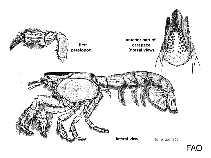Upogebia capensis (Krauss, 1843)
Cape mud shrimpWarning: DOMDocument::load(): SSL operation failed with code 1. OpenSSL Error messages: error:140770FC:SSL routines:SSL23_GET_SERVER_HELLO:unknown protocol in C:\Apache24\htdocs\includes\SpeciesSummary.lib.php on line 1236
Warning: DOMDocument::load(): Failed to enable crypto in C:\Apache24\htdocs\includes\SpeciesSummary.lib.php on line 1236
Warning: DOMDocument::load(https://sealifebase.nrm.se/webservice/AquaMaps/getAMap.php?genus=Upogebia&species=capensis): failed to open stream: operation failed in C:\Apache24\htdocs\includes\SpeciesSummary.lib.php on line 1236
Warning: DOMDocument::load(): I/O warning : failed to load external entity "https://sealifebase.nrm.se/webservice/AquaMaps/getAMap.php?genus=Upogebia&species=capensis" in C:\Apache24\htdocs\includes\SpeciesSummary.lib.php on line 1236
Upload your photos
Google image | No image available for this species;
drawing shows typical species in Upogebiidae.
Google image | No image available for this species;
drawing shows typical species in Upogebiidae.
Classification / Names Common names | Synonyms | CoL | ITIS | WoRMS
| Decapoda | Upogebiidae
Environment: milieu / climate zone / depth range / distribution range Sinh thái học
. Subtropical; 26°S - 37°S, 16°E - 35°E (Ref. 4)
Sự phân bố Các nước | Các khu vực của FAO | Các hệ sinh thái | Những lần xuất hiện | Những chỉ dẫn
Southeast Atlantic and Western Indian Ocean: South Africa and Mozambique.
Length at first maturity / Bộ gần gũi / Khối lượng (Trọng lượng) / Age
Maturity: Lm ? range ? - ? cmCommon length : 1.6 cm TL con đực/không giới tính; (Ref. 4)
Short description Hình thái học
Rostrum ending in three teeth; the lateral teeth are placed at the end of a ridge that is separated from the central part of the dorsal surface of the rostrum by a deep groove. On the central part itself a very shallow median groove is present. There are no ventral teeth on the rostrum. The anterolateral border of the carapace with a single spine behind the eye. First pereiopods subchelate. Dactylus of adult male with a longitudinal groove on either lateral surface, and without a tooth on the cutting edge. Palm with 2 dorsal denticulate carinae. Merus without an anterodorsal spine. Coxae of first three pereiopods without spines (Ref. 4).
It has lengths of 1.5 to 1.6 cm, total body length; 2.7 to 6.5 cm, ovigerous females (Ref. 4). It burrows in sandy mud of estuaries form mid-tide to LWS [= Low water spring tide]. It is a detritus feeder (Ref. 4).
Life cycle and mating behavior Chín muồi sinh dục | Sự tái sinh sản | Đẻ trứng | Các trứng | Sự sinh sản | Ấu trùng
Members of the order Decapoda are mostly gonochoric. Mating behavior: Precopulatory courtship ritual is common (through olfactory and tactile cues); usually indirect sperm transfer.
Main reference
Các tài liệu tham khảo | Người điều phối | Người cộng tác
Holthuis, L.B. 1991. (Ref. 4)
IUCN Red List Status (Ref. 130435)
CITES status (Ref. 108899)
Not Evaluated
CMS (Ref. 116361)
Not Evaluated
Threat to humans
Human uses
mồi: usually
| FishSource |
Các công cụ
Thêm thông tin
Các nước
Các khu vực của FAO
Các hệ sinh thái
Những lần xuất hiện
Những chỉ dẫn
Stocks
Sinh thái học
Thức ăn
Các loại thức ăn
Các khu vực của FAO
Các hệ sinh thái
Những lần xuất hiện
Những chỉ dẫn
Stocks
Sinh thái học
Thức ăn
Các loại thức ăn
Tên thường gặp
Các synonym ( Các tên trùng)
Các động vật ăn mồi
Sự tái sinh sản
Chín muồi sinh dục
Đẻ trứng
Sự sinh sản
Các trứng
Egg development
Các synonym ( Các tên trùng)
Các động vật ăn mồi
Sự tái sinh sản
Chín muồi sinh dục
Đẻ trứng
Sự sinh sản
Các trứng
Egg development
Các nguồn internet
BHL | BOLD Systems | CISTI | DiscoverLife | FAO(Publication : search) | Fishipedia | GenBank (genome, nucleotide) | GloBI | Gomexsi | Google Books | Google Scholar | Google | PubMed | Cây Đời sống | Wikipedia (Go, tìm) | Tạp chí Zoological Record
Estimates based on models
Price category
(Ref. 80766):
Unknown.



